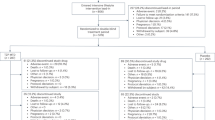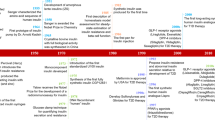Abstract
Vascular hypertrophy and insulin resistance have been associated with abnormal left ventricular (LV) geometry in population studies. We wanted to investigate the influence of vascular hypertrophy and insulin resistance on LV hypertrophy and its function in patients with hypertension. In 89 patients with essential hypertension and electrocardiographic LV hypertrophy, we measured blood pressure; insulin sensitivity by hyperinsulinaemic euglucaemic clamp; minimal forearm vascular resistance (MFVR) by plethysmography; intima-media cross-sectional area of the common carotid arteries (IMA) by ultrasound; and LV mass, relative wall thickness (RWT), systolic function and diastolic filling by echocardiography after two weeks of placebo treatment. LV mass index correlated to IMA/height (r=0.36, P=0.001), serum insulin (r=−0.25, P<0.05), plasma glucose (r=−0.34, P<0.01), and showed a tendency towards a correlation to insulin sensitivity (r=0.21, P=0.051), but was unrelated to MFVR. Deceleration time of early diastolic transmitral flow positively correlated to IMA/height (r=0.30, P<0.01). The ratio between early and atrial LV filling peak flow velocity negatively correlated to MFVRmen (r=−0.30, P<0.05). Endocardial and midwall systolic LV function were not related to vascular hypertrophy, plasma glucose, serum insulin or insulin sensitivity. In conclusion, insulin resistance was not related to LV hypertrophy or reduced LV function. However, high thickness of the common carotid arteries was associated with LV hypertrophy and high deceleration time of early diastolic transmitral flow. High MFVR was associated with low ratio between early and atrial LV filling peak flow velocity. This may suggest that systemic vascular hypertrophy contributes to abnormal diastolic LV relaxation in patients with hypertension and electrocardiographic LV hypertrophy.
This is a preview of subscription content, access via your institution
Access options
Subscribe to this journal
Receive 12 digital issues and online access to articles
$119.00 per year
only $9.92 per issue
Buy this article
- Purchase on Springer Link
- Instant access to full article PDF
Prices may be subject to local taxes which are calculated during checkout

Similar content being viewed by others
References
Jones EC et al. Relation of hemodynamic volume load to arterial and cardiac size. J Am Coll Cardiol 1997; 29: 1303–1310.
Olsen MH et al. Is cardiovascular remodeling in patients with essential hypertension related to more than high blood pressure? A LIFE substudy. Am Heart J 2002; 144: 530–537.
Phillips RA et al. Relation among left ventricular mass, insulin resistance, and blood pressure in nonobese subjects. J Clin Endocrinol Metab 1998; 83: 4284–4288.
O'Rourke MF, Yaginuma T, Avolio AP . Physiological and pathophysiological implications of ventricular/vascular coupling. Ann Biomed Eng 1984; 12: 119–134.
Ting CT et al. Arterial hemodynamics in human hypertension. J Clin Invest 1986; 78: 1462–1471.
Howard G et al. Insulin sensitivity and atherosclerosis. The Insulin Resistance Atherosclerosis Study (IRAS) Investigators. Circulation 1996; 93: 1809–1817.
Olsen MH et al. Relative influence of insulin resistance versus blood pressure on vascular changes in longstanding hypertension. ICARUS, a LIFE substudy. J Hypertens 2000; 18: 75–81.
Dahlof B et al. Characteristics of 9194 patients with left ventricular hypertrophy: the LIFE study. Hypertension 1998; 32: 989–997.
Howard G et al. Carotid artery intimal-medial thickness distribution in general populations as evaluated by B-mode ultrasound. ARIC investigators. Stroke 1993; 24: 1297–1304.
DeFronzo RA, Simonson D, Ferrannini E . Hepatic and peripheral insulin resistance: a common feature of type 2 (non-insulin-dependent) and type 1 (insulin-dependent) diabetes mellitus. Diabetologia 1982; 23: 313–319.
Polonsky KS, Given BD, van Cauter E . Twenty-four-hour profiles and pulsatile patterns of insulin secretion in normal and obese subjects. J Clin Invest 1988; 81: 442–448.
Lillioja S, Bogardus C . Obesity and insulin resistance: lessons learned from the Pima Indians. Diabetes Metab Rev 1988; 4: 517–540.
Ader M, Bergman RN . Insulin sensitivity in the intact organism. Baillieres Clin Endocrinol Metab 1987; 1: 879–910.
Best JD, Taborsky-GJ J, Halter JB, Porte D . Glucose disposal is not proportional to plasma glucose level in man. Diabetes 1981; 30: 847–850.
Folkow B . Physiological aspects of primary hypertension. Physiol Rev 1982; 62: 347–504.
Cooper KE, Edholm OG, Mottram RF . The blood flow in skin and muscle of the human forearm. J Physiol 1954; 128: 258–267.
Palmieri V et al. Reliability of echocardiographic assessment of left ventricular structure and function: the PRESERVE study. Prospective Randomized Study Evaluating Regression of Ventricular Enlargement. J Am Coll Cardiol 1999; 34: 1625–1632.
de Simone G et al. Assessment of left ventricular function by the midwall fractional shortening/end-systolic stress relation in human hypertension. J Am Coll Cardiol 1994; 23: 1444–1451.
Gaasch WH et al. Stress-shortening relation and myocardial blood flow in compensated and failing canine hearts with pressure-overload hypertrophy. Circulation 1989; 79: 872–883.
Dubin J, Wallerson DC, Cody RJ, Devereux RB . Comparative accuracy of Doppler echocardiographic methods for clinical stroke volume determination. Am Heart J 1990; 120: 116–123.
Nishimura RA, Abel MD, Hatle LK, Tajik AJ . Assessment of diastolic function of the heart: background and current applications of Doppler echocardiography. Part II. Clinical studies. Mayo Clin Proc 1989; 64: 181–204.
Appleton CP, Hatle LK, Popp RL . Relation of transmitral flow velocity patterns to left ventricular diastolic function: new insights from a combined hemodynamic and Doppler echocardiographic study. J Am Coll Cardiol 1988; 12: 426–440.
Klein AL et al. Effects of age on left ventricular dimensions and filling dynamics in 117 normal persons. Mayo Clin Proc 1994; 69: 212–224.
Andersen L et al. Enzyme immunoassay for intact human insulin in serum or plasma. Clin Chem 1993; 39: 578–582.
Roman MJ et al. Parallel cardiac and vascular adaptation in hypertension. Circulation 1992; 86: 1909–1918.
Saba PS et al. Relation of arterial pressure waveform to left ventricular and carotid anatomy in normotensive subjects. J Am Coll Cardiol 1993; 22: 1873–1880.
Bergbrant A, Hansson L, Jern S . Interrelation of cardiac and vascular structure in young men with borderline hypertension. Eur Heart J 1993; 14: 1304–1314.
Agabiti-Rosei E et al. Relation between cardiac hypertrophy and forearm vascular structural changes before and during long-term antihypertensive treatment. Am J Med 1988; 84: 125–128.
Olsen MH et al. The importance of changes in conduit and peripheral arteries for coronary flow reserve in patients with hypertension. A LIFE substudy. J Am Coll Cardiol 1999; 33: 279A.
Acknowledgements
We acknowledge the technical assistance by Lisa Krause in Ann Arbor, Merete Molvig in Oslo and Ingrid Emanuel in Copenhagen.
Author information
Authors and Affiliations
Corresponding author
Additional information
Supported in part by grant from Merck & Co., Inc., West Point, PA, USAPotential conflicts of interest: None
Rights and permissions
About this article
Cite this article
Olsen, M., Hjerkinn, E., Wachtell, K. et al. Are left ventricular mass, geometry and function related to vascular changes and/or insulin resistance in long-standing hypertension? ICARUS: a LIFE substudy. J Hum Hypertens 17, 305–311 (2003). https://doi.org/10.1038/sj.jhh.1001545
Received:
Revised:
Accepted:
Published:
Issue Date:
DOI: https://doi.org/10.1038/sj.jhh.1001545
Keywords
This article is cited by
-
Insulin resistance and vascular remodelling, in relation to left ventricular mass, geometry and function: an answer to LIFE?
Journal of Human Hypertension (2003)



